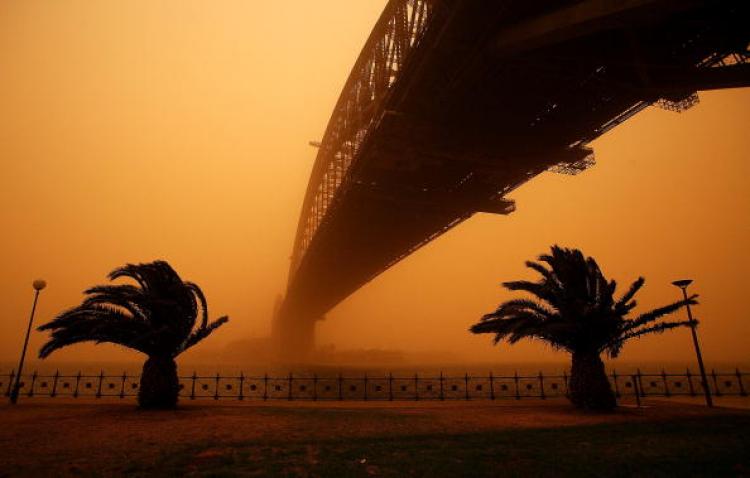SYDNEY—The early morning light, combined with the millions of tons of red dust, put Sydney, Australia in a thick orange shroud when an unusual dust storm hit on Wednesday Sept. 23, making visibility almost nil and causing havoc for transport and emergency services.
Over 20 international flights were diverted or cancelled during the morning, the Sydney harbor ferry service was forced to halt, and state emergency services were running spare, called out to fix alarms which had been triggered by the dust.
Air pollution levels jumped to 1,500 times their normal level, the highest on record, and warnings were sent out to those with asthma or respiratory problems to stay indoors. Local radio stations ran hot with calls from residents, many saying it was the “eeriest morning” they had ever experienced.
“It did feel like Armageddon,” said one caller to a local radio station who said she could see little except for “a red glow coming through.”
Dr. Blair Trewin from the Bureau of Meteorology says dust storms are not unusual for this time of year but the extent of this storm was what had made it a stand out.
Normally if you’ve got storm winds they would be a bit more localized and the dust would not be carried quite as far,” he said. “You would certainly have to go back many years for the last time we saw dust covering such a wide area as this.”
The storm—which blew at over 100 kilometers an hour (62 mph) in some areas—dumped red dirt from Broken Hill in the west of New South Wales, through Canberra and the Southern Highlands, into Sydney and then continued up the Hunter Valley and the north coast to hit Brisbane later in the day.
Farming Practices to Blame
Traditional farming practices are partly to blame for Sydney’s extraordinary dust storm, one of the biggest in the nation’s history, say environmental scientists.
Professor Stewart Franks from the University of Newcastle said it is inevitable that dust storms would come about from the extreme drought conditions Australia has experienced over the last few years but traditional agricultural practices contribute significantly ,“ripping and destroying the soil” and leaving it vulnerable to topsoil flight.
“Standard ploughing of agricultural fields in Australia in a drought leads to the breakdown of the soil and it produces these fine particles which are so easily picked up by the atmosphere,” he said.
“Alternatives like ‘no-till agriculture’, where you can actually farm land and improve the soil at the same time” were already developing a following in Australia’s farming communities, he said, but there was still a long way to go.
“I guess a lot of farmers were wishing they were no-till farmers [today],” he said. “They have lost a layer of topsoil.”
Top Soil Loss
Dr. John Leys, the Southern coordinator for Dust Watch, a part of New South Wales Department of Environment and Conservation, said the size and extent of the storm was extraordinary.
“It’s travelled about 1,500 kilometers (932 miles) to get to Sydney,” Dr Leys said.
He said the storm was the result of concentrated storm activity in South Australia over the last few weeks, and estimated that enough dust to fill 4,000 semi-trailers was blowing out to sea every hour. Stephen Cattle is a senior lecturer of soil science at Sydney University said the loss of top spoil would hit farmers hard.
“The topsoil is often some of the better soil because lower down the soil becomes a bit more salty, a bit more sodium rich and not so hospitable for plant growth so by losing the top soil in particular where most of our organic matter resides, most of our organic carbon resides, it represents quite a loss to the productivity or the potential productivity of that soil,” he told the ABC.
Living on a dry continent did contribute to these sorts of dust storm activities, he said, but bad land management was a big contributor.
“Over-grazing in particular can cause disruption of the top soil which leaves particles less aggregated and therefore much easier for the wind to pick up.”






